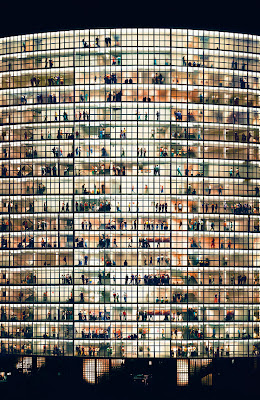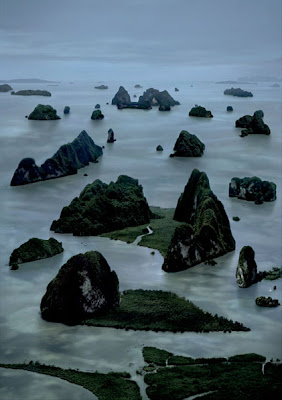
(Note - see the follow up post here)
I took the latest Modern Painters with me to read at the cottage a while back, optimistically thinking that with a 3 and a 5 year old, the lake ice just melted, bugs, frogs, porcupines and bunnies everywhere, dead-falls to clear and plumbing to fix I would actually have time to read it...

So, I finally got down to reading the glowing article on the new Gursky work yesterday (there's also a good little piece on Boris Mikhailov). And today I find a link at Winkleman to a somewhat (though not entirely) critical review in New York Magazine - "It’s Boring at the Top" - of the new Gursky show at the Matthew Marks Gallery (and here):
Is Andreas Gursky—the highest-priced photographer alive—running out of ideas?
The German über-photographer Andreas Gursky was the perfect pre-9/11 artist. He excelled at portraying the border-to-border, edgeless hum and busy obliviousness of modern life, what Francis Fukuyama ridiculously declared “the end of history,” George W.S. Trow called “The Context of No Context,” and Rem Koolhaas dubbed “Junkspace.” Not only did Gursky seem to be critical of all this, but his handsome images of trading floors, hotel lobbies, raves, and landscapes were charged with a visual force and intellectual rigor that let you imagine that you were gleaning the grand schemes and invisible rhythms of commerce and consumption. His amazing picture of a convenience store brimming with goods, 99 Cent II, Diptych (2001), which recently became the most expensive photo in history when it was auctioned for over $3.3 million, fizzed like cherry cola but packed the formal power of a Monet.
Unfortunately, as smart and deft as this artist still is, that fizz has gone flat, the power has run low, the former buzz has become a drone. The times have changed, but Gursky is still trying to render purring pre-9/11 space, where commerce ticked along without an undercurrent of fear. But his rigor and criticality have been replaced by grandiosity and theatricality; figures feel frozen; compositions are stagy; structure devolves into carpet like pattern. Gursky’s new pictures are filled with visual amphetamine, but now they’re laced with psychic chloroform. He’s such a serious artist that this amphetamine is singular enough to sometimes offset the deadening effects so that his pictures occasionally impart a poetics of numbness and stupefaction...
...Gursky has digitally pieced together numerous shots from various locations, including his studio, making F1 less a photograph than an invention, and what’s tedious about it is how coyly self-referential it is. Directly above the pit crews are onlookers in a glassed-in observation deck. Many of these folks take photos; a few have their hands against the clear surface of the skybox. Thus, the frontality of the image and the idea of multiple views of one subject is stressed. Standing between the crews is a sexy blonde in lace-up leather stilettos, hot pants, and a skull on her low-slung belt buckle, which is conveniently positioned almost at the center of the picture. Is Gursky implying that men are drones and women are merely saints, sluts, sirens, or fodder for fashion photography, cheesecake, and pornography? Or maybe he’s admitting that he’s out of ideas.
In this I tend to agree on the whole. I remember the excitement when I first encountered Gursky's work - leafing through the books and articles several times - renewed when I saw my first massive Gurskys at the Tate Modern, but I haven't felt the same rush for some time now, while still enjoying - and being inspired by - that first big section of work. What now it seems? As Ed Winkleman says in a slightly different context "He used to be so bleeding edge, and now he's really just riding that wave, churning out signature work with a seasonal/fashionable update every so often."...
BTW, for my money, Thomas Struth's less flamboyant working away at his various projects is still bearing fruit and seems to have much more staying power. Though I also hope Grusky gets his rhythm back and gets back in the groove with something new and good - there is still something about his work - even this new stuff - that can mesmerise you.

POSTSCRIPT: I notice Joerg at Conscientious has picked up on the comments about the new Gursky show (which, of course, almost none of us have seen first hand...). He seems a little worried that we are in danger of treating artists like entertainers. Leaving aside for now the strong argument that could be made that regarding artists as entertainers is nothing new and sometimes appropriate, I want to compare the response to Gursky's new work with that to Thomas Struth's new Museum work. Struth takes an old theme of his - people and museums - and works it deeper and more effectively. On the whole the reviews of Struth's new work have been positive (extremely positive in many cases) - Adrian Tyler just described the Prado show to me as "exquisite", but Struth is essentially doing the same thing here as Gursky in terms of artistic process. Expanding the work of an existing them. Yet as far as I can tell, Struth seems to been much more successful at doing so.
I mentioned the Modern Painters review of the Gursky work - I came away from it empty. It very much felt as though the writer was having to go through all sorts of convolutions using ancient Chinese concepts of blandness (which in itself might be an interesting thread to follow) and quoting Barthes in order to try an justify Gursky's work. Indeed I'm sure the Gursky work is impressive first hand. I'm just getting the feeling it isn't as good as what he's done before and is a bit of a misstep.
Finally the Guardian, while slightly more restrained about the Gursky work, was not exactly enthusiastic:
age....In his most recent work, Gursky has employed digital technology, resulting in even more crisp detail as well as the potential to manipulate the image. Kamiokande (2007) portrays an underground chamber designed to detect the smallest-known particles in the universe, the extraordinary architecture and scale of the chamber determined only by two tiny figures at the bottom of the picture. Elsewhere, the extraordinary natural poeticism of the James Bond Island images seduce, even as you try to spot Daniel Craig in his swimming trunks.
Gursky has visited Japan, Thailand and Korea in preparation for this show, apparently in pursuit of new subject matter to satisfy the potential of new technology. It makes you nostalgic for the ordinary everydayness of his earlier work, whose honesty seems to have been lost in the quest for the more extraordinary im







1 comment:
Post a Comment